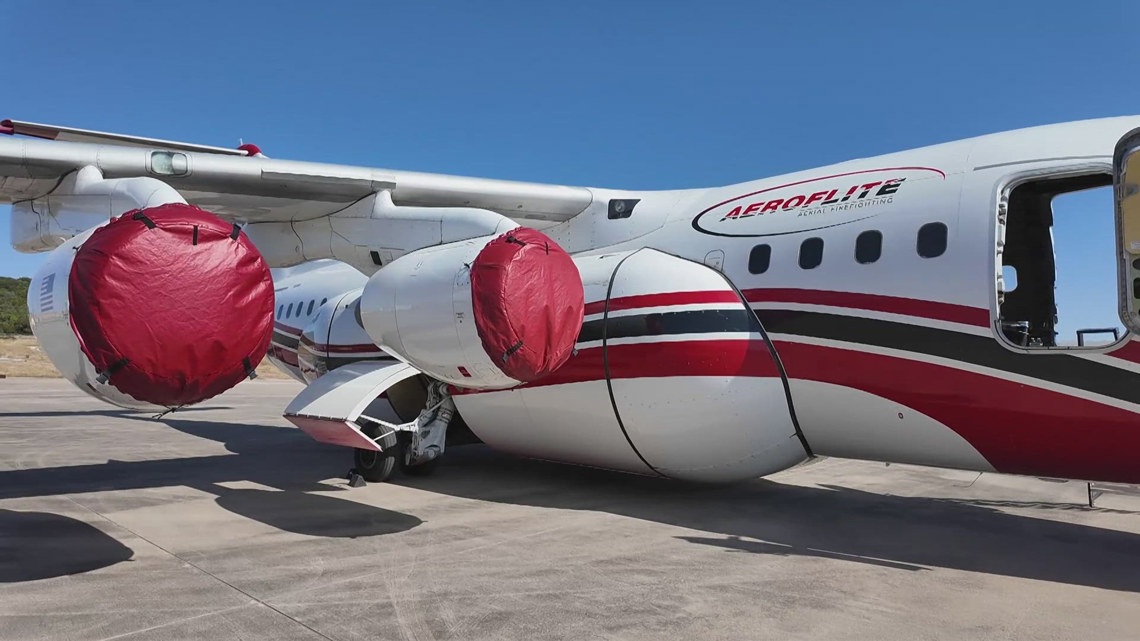Texas A&M Forest Service’s air tankers can reach any Texas fire within an hour, carrying 27,000 pounds of retardant and launching in 15 minutes.
KILLEEN, Texas — When wildfires threaten Texas communities, help arrives from the sky at 400 miles per hour.
The Texas A&M Forest Service has stationed specialized air tankers at Killeen Regional Airport, adding a crucial piece to the state’s wildfire defense strategy. These converted Avro 146 airliners carry 3,000 gallons of fire retardant and can be airborne within 15 minutes of receiving a call.
“We’re called a tanker. Some people hear that and they think like, you know, over the road 18 wheeler, but no, we’re a flying tank of fire retardant or water,” said Tim Meade, an AKP trainee with Aeroflite.
In the race against wildfire, these air tankers have a significant advantage over ground crews.
“Oftentimes ground resources are just pulling out of the station in 15 minutes,” Meade explained. “They have to drive, get on scene, get to work. We’re flying. We’re much faster.”
The aircraft cruises at 350 knots — roughly 400 miles per hour — allowing it to reach any location in Texas within an hour. That rapid response time can mean the difference between saving a home and losing it to flames.
Cassidy Ince, Aviation Program Coordinator with Texas A&M Forest Service, said Killeen’s central location makes it an ideal base for aerial firefighting operations.
“Killeen, being centrally located, provides a prime opportunity for us to stage aircraft here so we can reach different parts of the state,” Ince said. “We have conversations with predictive services and operations to decide where in the state we have the most critical risk and we strategically move our aircraft around the state.”
The bright red retardant dropped from these tankers isn’t designed to extinguish fires directly. Instead, it serves a more strategic purpose.
“The purpose of the retardant isn’t necessarily to put the fire out,” Meade said. “It’s used to steer it and slow it down so that the resources on the ground can have better attack and better efficiency at putting the fire out.”
Each aircraft carries 27,000 pounds of retardant — about 3,000 gallons. Pilots can release the entire load at once or in sections, depending on what’s needed on the ground.
In the cockpit, a guarded red switch on the control wheel allows either pilot to drop the retardant. There’s also an emergency jettison system that can dump the entire load in seconds if an engine fails during takeoff.
“We have to get rid of that weight very quickly,” Meade explained. “This system will jettison that load really fast, so we go from being in a pretty precarious spot to being OK pretty quick.”
Becoming an air tanker captain requires months of intensive training. Pilots must learn every switch, circuit breaker, and emergency procedure on the aircraft.
“Our training is several months long,” Meade said. “We learn every light switch and circuit breaker on the jet and what they’re used for and how to use them at the appropriate time.”
There are two types of captains in aerial firefighting. A regular captain (AKP) can drop on fires with aerial supervision present. An initial attack captain (AKI) can respond alone, size up the situation, and begin operations without any supervision.
Once airborne, pilots immediately coordinate with dispatch centers to develop a game plan. Sometimes they’re the first aircraft on scene. Other times, they join multiple aircraft already working the fire.
“It’s a busy, I don’t want to say chaotic, but a fast tempo, fast-paced process,” Meade said.
For Meade, one fire response in eastern Montana last year remains vivid in his memory.
Lightning had sparked multiple fires across the landscape. As the day progressed and temperatures rose, individual fires merged into larger threats. Meade’s crew responded to a home in the path of advancing flames.
“We got on scene and you could see their windows were open. You could see the curtains blowing in the breeze. There were kids’ toys out in the yard,” Meade recalled. “It was just a standard American household, a family with children, and you could tell nobody was home.”
The family was likely running errands — grocery shopping, perhaps picking up children from school — completely unaware that fire was threatening their home.
“They have no idea that a fire is threatening their home. They have no idea that we’re even here,” Meade said. “Especially in more sparsely populated areas, you know, Wyoming, Montana, a lot of Texas, our response time is such that we have an opportunity to try to save that.”
Despite their efforts, the crew couldn’t save that particular home. But the experience reinforced the importance of their mission.
“It’s something that we take pretty serious,” Meade said.
Ince emphasized that successful aerial firefighting operations require coordination across multiple agencies and organizations.
“It takes a village to be successful,” she said. “Not only out of state resources that come to help staff our bases, the vendors here, the local communities, the airport operations here in Killeen — it literally takes a village to be successful, and we’re so lucky to live in a state that jumps at any opportunity to help.”
The air tankers currently stationed in Texas are on federal contracts and will remain in the state as long as wildfire risk remains elevated. The Texas A&M Forest Service continuously monitors conditions and strategically positions aircraft where they’re most needed.
“We try to be out of sight, out of mind,” he said. “We don’t really want the general public to know that we’re here. Our job is to assist.”

